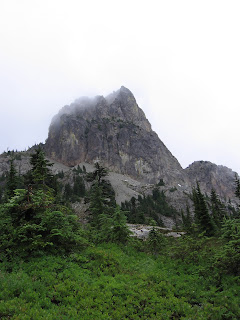 December 26, 2009
December 26, 2009We were hoping to get to do some snowshoeing the day after Christmas, and the guidebooks offered up Marten Creek as an off-the beaten-path narrow meandering forest trail rich with wildlife. Cougars were mentioned. Alas, we spotted no wildlife -- not even a squirrel -- and there was only a dusting of snow, but Martens Creek is indeed secluded and darn pretty.
Marten Creek is in the Alpine Lake Area, and only a little over an hour's drive from Seattle. There is parking along the road on both sides. We arrived at the trailhead a little over 10:00 and started suiting up. True to its secluded description, there were no other cars parked there, and we only saw one car go by the entire time we were getting ready. Since this was our first attempt at snowshoeing we had to grapple with gaiters and mittens and figuring out how to strap our snowshoes to the packs.
The trail starts with some long, steady switchbacks. It's definitely a serious uphill, but nothing too crazy. However, I'm just getting over the infamous H1N1 Flu and was surprised at how winded I got on this portion. I also got extra hot, also a result of being not quite well, so it was a sweaty, wheezy, uncomfortable start for me. I kept telling myself I was sweating the last of the virus out :)
The trail more or less levels off after about a mile. Though there had been a dusting of snow on the road where we had parked, everything along the trail was completely barren of snow. It was rather warm too, and getting warmer as we walked, so we were
 stuffing gloves and hats into packs as we went. Every description we had read said that there was almost always snow here, even if the first bit of the trail didn't have any. But the further we got, the less likely it seemed that we were going to see any snow.
stuffing gloves and hats into packs as we went. Every description we had read said that there was almost always snow here, even if the first bit of the trail didn't have any. But the further we got, the less likely it seemed that we were going to see any snow.Marten Creek has some interesting history to it. In the late 1800s and early 1900s, prospectors discovered ore at the head of Marten Creek. The trail is actually an old miner's path that used to link to Granite Pass. The mines never produced much, and the area was abandoned. There was also a big forest fire here in 1897, and the Forest Service used the area for a plantation project, planting seedlings from various areas in marked groves in 1925. There's an interpretive sign not too far from the beginning of the trail, explaining the experiments.
You are definitely in the woods here. Though it was early in the day, portions of the trail were just dark. I was reminded of all the forest myths about the dark and mysterious nature of the forest an the creatures that resided there, and more than once I was reminded of the line from Frost's poem, "The woods are lovely, dark, and deep."
As we got a little further on, we had a great view of the peak at one end of Gordon Ridge, and, in the distance, through Granite Pass you could see the jagged peak of Three Fingers. As we went further along the trail, it got noticeably colder, and the hats and gloves came back out. We started seeing snow, and were hopeful that we might actually get to do a little snowshoeing, but there was never more than a few inches of snow on the ground. Snow covered branches did make for some beautiful winter scenery.

The trail got much wilder as we neared the end. There were lots of downed trees, and snow covered brush that would sprinkle snow down your neck as you passed by. At one point in the trail, the easiest way ahead was to slither under a couple downed trees on my stomach, army style. Eventually, the trail runs into the creek and just sort of peters out. I have to admit, it's sort of an unsatisfactory ending to a hike -- no summit, no lake, no sign -- we just sort of looked at each other and shrugged, as if to say, well I guess that's it.
We were disappointed we didn't see any wildlife, and of course, that there wasn't any serious snow, but we did have two rather exciting moments. As we neared the end of the trail at the creek, we heard some loud popping, almost like gunshots, followed by a deep rumble. We thought it was an avalanche on a neighboring mountain. Later, as we were just back to the parking area, we heard a similar popping sound and Michael actually saw the top of a huge evergreen get sheared off. There were some incredibly powerful gusts of wind as we came off the trail and a wind advisory was in effect. So, what we thought was an avalanche earlier might have been some cracking and falling trees.
All in all, it was a nice winter hike. This is definitely a deeply forested and secluded spot, and we'll have to come back when there is some real snow to give it a run in showshoes.
Directions: From Granite Falls drive the Mountain Loop Highway about 9 1/2 miles past the Verlot Public Service Center and look for the Marten Creek trailhead on your left, beyond the Marten Creek bridge, at an elevation of 1,415 feet.






























